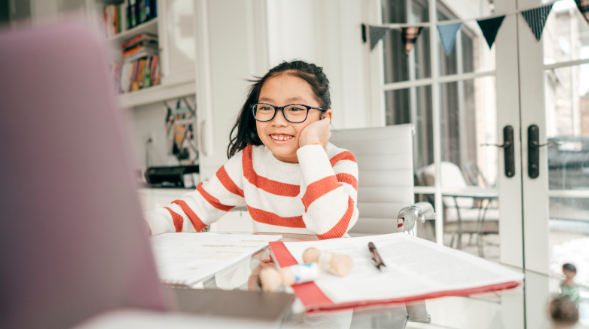
When we think about education, we often focus on curriculum, teaching methods, and resources. However, the physical environment where learning takes place plays a crucial role in focus, creativity, and retention. For homeschooling families, interior design isn’t just about aesthetics it’s about creating a space that actively supports education.
Science backs this up: a well-designed space enhances concentration, reduces stress, and improves learning outcomes. By customizing your homeschool environment to fit your child’s needs, you can create a space that inspires engagement and maximizes productivity.
The Science of Learning Environments
How Space Affects the Brain
Our brains constantly respond to our surroundings. Clutter, poor lighting, or uncomfortable furniture can make learning harder, while an organized, well-lit space can boost focus and retention.
Even temperature plays a role too hot or too cold, and concentration drops. Color also has a psychological impact on learning. Blues and greens create a calm and focused atmosphere, making them ideal for subjects that require concentration.
Meanwhile, yellows and oranges stimulate creativity and energy, making them great for hands-on or artistic activities. Using color strategically can help shape an ideal learning space tailored to your child’s needs.
The Power of Natural Light
Natural light has a huge impact on mood, alertness, and productivity. A homeschool space flooded with natural light will enhance engagement and lessen exhaustion. Place desks near windows for exposure to natural light, choose light-colored walls, and consider using mirrors to reflect light as additional measures for maximizing brightness.
If natural light is limited, full-spectrum light bulbs can mimic daylight, creating a similar effect. Even small adjustments in lighting can make a big difference in how well children focus and absorb information.
Integrating Technology Thoughtfully
Technology is an essential part of modern education, but it should be integrated in a way that enhances learning rather than causing distractions.
Setting Up a Digital Learning Station
Set up screens at the right height to reduce eye strain, keep cables neatly managed, and use ergonomic seating for extended learning sessions. A well-organized tech station enhances focus and comfort. For homeschooling students attending online tutoring sessions, a digital learning station should be designed to support both virtual lessons and independent study.
Creating a dedicated space for offline work alongside the tech station can help balance screen time, providing room for writing, drawing, or hands-on projects.
Balancing Screen Time and Hands-On Learning
Although technology is beneficial, you must also balance screen time with physical interaction. Consider creating tech-free spaces that can be used for reading/writing and a space for artistic design and creative projects.
Also, use a timer to limit screen time, but let the kids engage in time out for creative movement experiences. A balanced usage of technology allows the child to learn digital literacy and provides time for traditional literacy experiences too.
Key Elements of an Effective Homeschool Design
Organization and Decluttering
A disorganized atmosphere can delightfully mess with your brain, challenging your focus and memory. A tidy and functional homeschool space starts with decluttering. Keep materials accessible yet tidy by putting them into labeled bins, baskets, or bookshelves.
Utilize vertical storage solutions like wall-mounted organizers or pegboards to maximize space. Keeping a clean and structured environment reduces distractions and helps children engage more effectively in learning.
Furniture and Ergonomics
Comfort plays a major role in learning efficiency. The right desk and chair setup can prevent discomfort and fatigue, keeping children focused for longer periods. Ensure
that your child’s feet rest flat on the floor, elbows remain at a 90-degree angle when writing or typing, and screens are positioned at or just below eye level.
Adjustable desks, standing workstations, or ergonomic seating like wobble stools can provide additional flexibility and movement, supporting better posture and engagement.
Managing Noise and Acoustics
Auditory distractions can have a strong effect on attention, particularly in the case of busy families. Many straightforward modifications can make a big difference in acoustics. Introducing a rug, curtains, and other fabric wall hangings can help soak up excessive noise while adding a bookshelf can serve as a sound barrier in shared rooms.
White noise machines or instrumental background music can also mask distracting household sounds, creating a more focused atmosphere. For families with multiple children learning together, quiet zones and noise-canceling headphones can support independent study.
Designing for Different Learning Styles
Every child learns differently, so designing a space that accommodates various learning styles is essential.
- Visual learners benefit from color-coded organization, whiteboards, bulletin boards, and clear visual displays of schedules and lessons.
- Auditory learners thrive in spaces with listening stations, good acoustics, and opportunities for verbal discussion.
- Kinesthetic learners need movement-friendly spaces with standing desks, fidget tools, or hands-on learning stations.
Creating flexible learning zones that cater to these styles allows children to engage in ways that work best for them.
Adapting for Growth and Changing Needs
A designated homeschool space should transform in a manner that accommodates the developmental continuity of your young one, and the evolution of their educational needs.
Generally speaking, younger children thrive in bright, interactive spaces that offer lots of options for seating; on the contrary, older students may benefit from more minimalism and restrictions. Regularly assess what you like and don’t like, and revamp as needed!
Using adaptable furniture, rotating learning materials, and reorganizing spaces based on your child’s developmental stage ensures that your homeschool environment remains effective over time.
Maximizing Small and Shared Spaces
Not every homeschooling family has a dedicated room for learning, but that doesn’t mean you can’t create an effective setup. Many families successfully homeschool in shared spaces like dining rooms, living areas, or even small nooks.
Creating Multi-Functional Spaces
When space is limited, flexibility is key. Use fold-down desks, rolling carts, or stackable storage bins that can be put away when learning time is over. Designate specific learning zones within shared rooms using rugs, furniture placement, or lighting changes. Wall-mounted organizers can help keep materials accessible without taking up floor space.
Storage and Organization Tips
Effective storage options will keep things organized, even in a small area. Put your teaching materials in labeled bins that can be easily stored out of sight when not in use. Keep commonly used supplies in a portable caddy or rolling storage cart. Use vertical storage solutions, such as bookshelf systems or hanging pockets, to help save space and avoid overwhelming the room.
Creating an Inspiring Learning Atmosphere
Interactive and Engaging Walls
Walls can be powerful learning tools. Whiteboards, chalkboards, or corkboards can serve as spaces for brainstorming, lessons, and goal setting. Educational posters, interactive maps, and rotating displays of student work make the space more dynamic and engaging. Keeping some elements permanent while rotating others can keep the environment fresh and motivating.
Bringing Nature Indoors
Nature has a soothing impact and contributes to learning by supporting focus and creativity. Including house plants, using natural wood furniture, or adding decor inspired by nature can lead to a more tranquil atmosphere. Even sometimes changing the environment to outdoor learning can relieve the regularity of the classroom and recharge children for learning.
Budget-Friendly Homeschool Design
Creating a functional homeschool space doesn’t have to be expensive. Many improvements can be made with simple, cost-effective solutions.
DIY and Upcycled Furniture
Updating old furniture is a great way to curate a customized learning environment without breaking the bank. Painting an old desk found at a second-hand store, using crates as modular storage options, or transforming bookshelves into learning centers are all inexpensive ways to bring new life into your learning environment.
High-Impact, Low-Cost Improvements
Small changes can have a big impact. Rearranging furniture, improving lighting, or adding inexpensive wall decals can refresh a space with minimal investment. Updating organizational systems and introducing simple decorative elements can make the space more inviting without breaking the bank.
Phased Approach to Improvements
Rather than overhauling your homeschool area completely, consider refreshing it slowly, step-by-step. Begin with fundamental categories including ergonomic furniture and lighting. Next, focus on making adjustments to storage and organization. After those changes, you can make adjustments over time to include more interactive elements and adjustments, making a space that works with your child.
Conclusion
Establishing a productive homeschool environment does not equate to being perfect but making better decisions to help support the learning journey of your child. When you focus on organization, comforting surroundings, lighting, and flexibility, you can create a productive and inspiring learning environment anywhere.
Stay open or flexible, regularly review your approach, and change as needed. An intentional homeschool environment will enhance education and make learning much more enjoyable regardless if you have an entire dedicated room or one part of a shared space.
FAQs
How can interior design affect the environment?
The sustainable interior design prioritizes using non-toxic, low VOC (volatile organic compounds) materials, which can significantly reduce the harmful chemicals released into the air. Additionally, incorporating natural materials like wood and stone can further contribute to healthy indoor air quality.
How can classroom design create an effective learning environment?
Children who work in a familiar classroom, with their work on display on the walls will feel a much greater responsibility to learn. If the furniture is comfortable, bright, and familiar it will create a warm and stimulating environment where children can learn and grow to the best of their ability.
What is the importance of interior design in the home?
Interior design significantly impacts our daily lives and well-being. It promotes relaxation at home, increases employee satisfaction at work, and encourages learning at school. The interior design expresses personal or brand identity.
